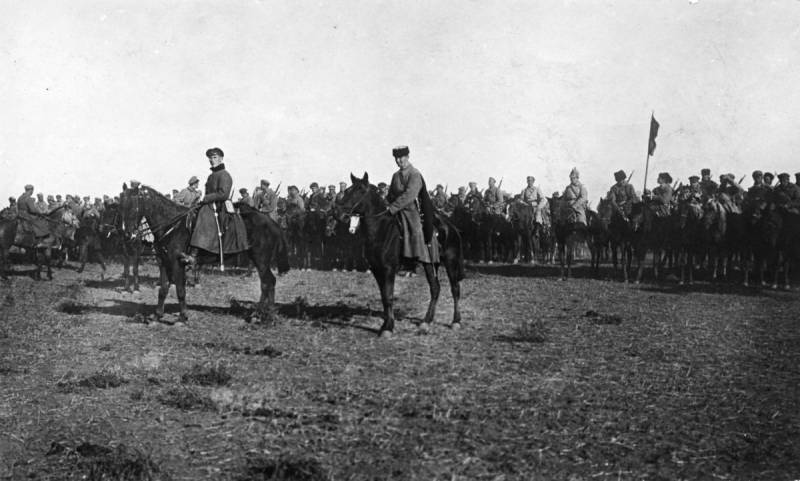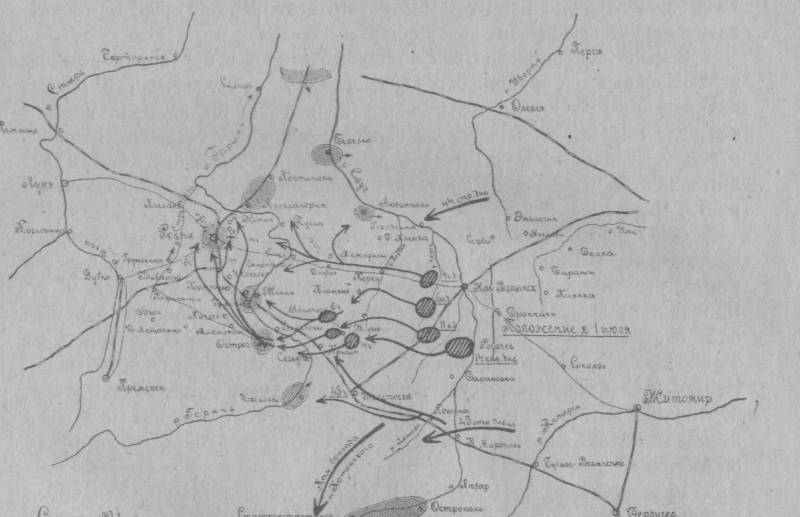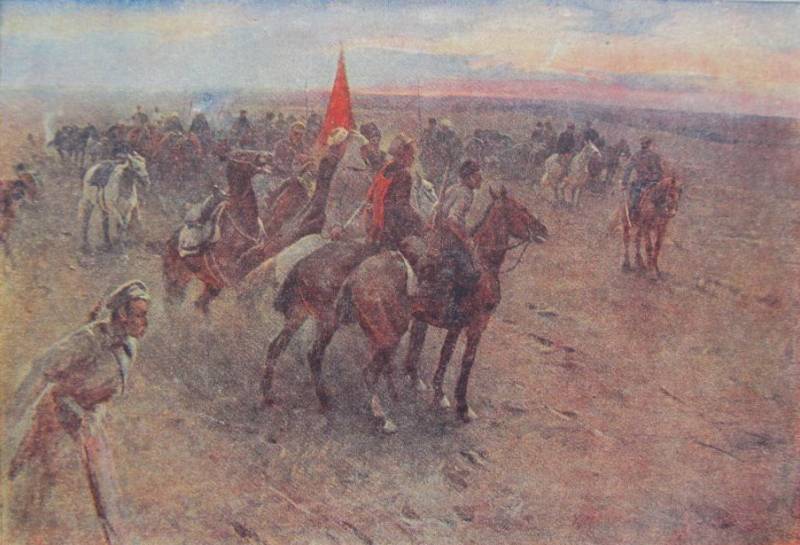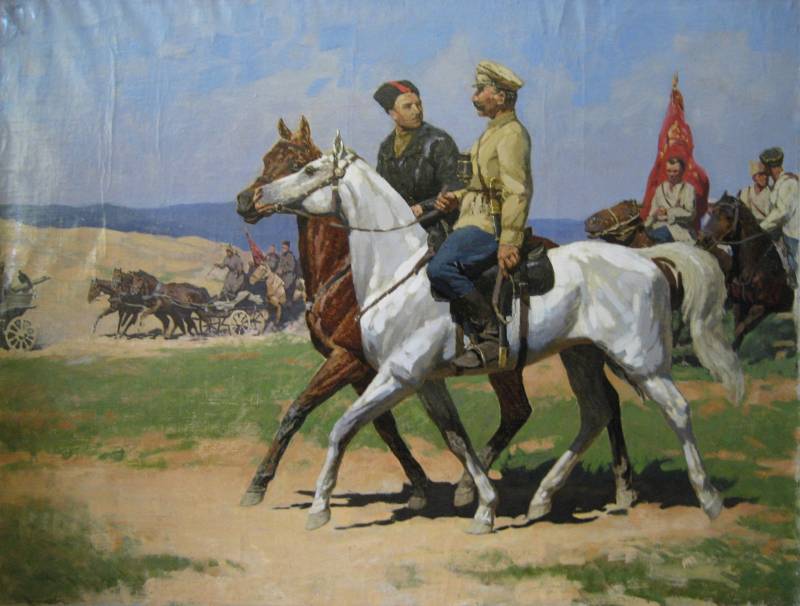Sword of the Southwestern Front. Throw of the 1-th Horse from Rivne to Dubno, July 1920-th
On the outskirts of Rivne
The 6 I Cavalry Division, at 17 hours crossing the river at Brodovo north of the railway bridge, took control of the railway bridge at the station. Ozhenin, having cut off the escape route to the 2-m Polish armored trains located at the station Brodovo. With the support of the infantry, the armored trains continued to conduct a stubborn battle with the Reds - firing hurricane fire at the advancing units of the 6 and 11 cavalry divisions. The battle for the crossing and the possession of armored trains lasted until late at night. Despite the persistence of the attacks of the Reds and the strong artillery fire over bridges, the Poles forced the Konarmi units that occupied Art. Ozenin, return to starting position. Remained in Polish hands and crossing at Brodovo.
By the 16-hours of the 2-th of July, the 14-th Cavalry Division reached the Shepetovka – Rivne railway and continued to advance on Ostrog — right along the highway. In 23 hours, under strong enemy rifle and machine gun fire, the division crossed the river. The mountains were east of the town of Ostrog, but due to the darkness and the late time they could not develop their success.
By the evening of the 2-th July, after a stubborn battle, the 405-th regiment of the 45-th infantry division occupied the city of Izyaslavl. In the Ostrog - Slavuta - Izyaslavl area, units of the 10-th reserve brigade of the enemy were found (as part of the 2-x infantry regiments, cavalry regiment with artillery and armored trains).
At the dawn of the 3 July, overcoming the fierce resistance of the enemy, the 6 and 11 I cavalry divisions forced in the area of Vilbovno r. Goryn and, having seized the town of Ostrog, continued to pursue the Poles - in the direction of Varkovichi. For the night, the 6 and 11 I cavalry divisions are located 10 km north of Ostrog, and the 14 I cavalry divisions are 5 km south of Ostrog.
At dawn on the 4 of July, all three cavalry divisions rushed north to capture Rivne.
The battle for Rivne and Rivne district
These divisions fought stubbornly all day with the enemy, who strove in every way to delay the vigorous movement of the cavalry army north. Due to the rugged, wooded area, Soviet units in places had to conduct a foot battle.
On the 4 of July, all parts of the army showed amazing restraint and coordination of actions. The skillful maneuvering of the 6 and 11 cavalry divisions led the enemy astray regarding the direction of the main attack of the 1 cavalry - which greatly helped the 14 cavalry divisions, bypassing the city from the southeast, appear at the enemy's rear.
At the same time, the 6-I cavalry division broke into Rivne from the north-west, and the 11-I cavalry division - from the south. And at 23 on the 4 of July, the city was in the hands of cavalrymen.
The attack on Rivne was so swift that the enemy did not manage to take anything out of the city and from the station. The rich booty was taken by the Reds: 1 armored train, radio station, train, 1500 horses, guns in the harness and a lot of ammunition.
Whereas the strike group of the army carried out an operation with the aim of capturing Rivne, the 4 I cavalry division, located at r. Groyn on the Rivne highway, provided the operation from the northeast. The division fought for the crossings at Tuchin - Goshcha. By the evening of July 3, it became clear that a strong enemy group (by force of at least 2 x infantry regiments with cavalry) appeared in the area of B. Kletski (north of Cape Korets) - in its rear.
Leaving the brigade at the crossings, the 4-I cavalry division on the 4 of July delivered a flank strike to an enemy group - and pursued it with one brigade to Ludwipol (on the Sluch river).
The prisoners showed that the Poles hastily transferred new troops (including cavalry) in the direction of Rivne. Military intelligence confirmed the concentration of the enemy in the area of Kostopol - Alexandria (north of Rivne). During the concentration of the Cavalry Army in the Rovno region, it became clear that the enemy, taking advantage of the slowness of the movement of the right-flank units of the 14 Army, removed the 13 Infantry Division from its right flank and sent it from the Starokonstantinov region in the general direction to Izyaslyavl - to the flank and rear of 45 -th Infantry Division (by the way, very few). At the same time, in the Dubno - Kremenets area, the Poles formed a group of General Shimansky (as part of the 18th Infantry Division and the brigade of the 5th Infantry Division).
The clarified threat on both flanks of the Horse Army and especially expressed on its left flank, where the enemy began to push the 45 rifle division, forced the front command to demand vigorous advance from the 12 and especially from the 14 armies to capture the last Staro-Konstantinov .
On the 5 of July, the 4th Cavalry Division crossed the Goryn River and joined the army in the area of Rivne.
So, the task set by the 1-th Cavalry Army, performed brilliantly. A slight delay occurred in the actions of the strike group at the crossings of the river. Groyn, but it had little effect on the final result of the operation.
Despite the difficult transitions and daily battles in very difficult terrain conditions with insufficient provision of people and horsemen, the red cavalrymen were strong in spirit and ready for new fierce battles with the enemy. The valor of the army was very high, since all its soldiers perfectly understood the importance of the struggle against Poland.
On the night of July 6, until the new front directive was received, the commander ordered the army (order 082 / op) to gain a foothold in the occupied area, conducting intensified reconnaissance, for which the head of the 4 Cavalry Division, in accordance with the situation in the Alexandria-Ludvipol area , it was ordered to concentrate the division in such a way as to repel the enemy in case of his advance from the north, for which one or two brigades (depending on the situation) should be located on the right bank of the river. Goryn in the area of metro Tuchin, creating a strong crossing here. The 6th Cavalry Division, while remaining in the occupied area, was ordered to set up guard guard to the west - along the Stubel River; 11-th Cavalry Division, located in the area Grushevitsa - Ulbarovo (on both sides of the highway to Dubno), - put up guard on the river. Stubel to metro Mizoch; 14-th Cavalry Division, located in the area Ivachkovo - Korostovo (south of Rivne), put up a guard on the line Mizoch - Menzherichi (near the town of Ostrog).
The 45th Infantry Division was ordered to liquidate the enemy in the area of Starokonstantinov - Ostropol (to the south-east of Izyaslavl) as soon as possible.
With these orders, the commander wanted to provide the army with the necessary rest, protecting its flanks from possible offensive attacks by the enemy. True, this arrangement created some dispersion of the army, but this dispersion was caused by the situation on the army front and, moreover, depended on economic reasons (difficulty in foraging, etc.).
On the 6 of July, a new front directive was received, ordering: The cavalry army to take (reconnaissance units) for crossing the rivers Styr and Ikva (Lutsk-Torgovitsa-Dubno district); destroy the enemy’s left flank in the area of Starokonstantinov - Ostropol; to assist the 12 Army, send one cavalry division to Berezne-Kostopol; to concentrate the main forces in the Rivne area for a further offensive in the direction of Lutsk - Vladimir-Volynsky - Grubeshov; Army immediately pull up the rear, tidy up the material part, forge horses and replenish the necessary supplies.
This directive of the army made it possible for some respite, which was completely legal after continuous combat work throughout the summer of 1920. But in fact, she did not receive this respite, since in the morning of the 6 July the Poles began to press intensely on the army from the north (from Alexandria - Ludwipol) and from the south (from Ostropol) to the 45 division.
All day on the July 6, the 4 Cavalry Division fought a fierce battle with the enemy, which was invading in the area south of Alexandria. The 11-I and 14-I cavalry divisions during the 6-th of July moved to the areas designated by order of 082 / op. There were no combat clashes in the army, except on the flanks (in the 4th cavalry and 45th rifle divisions). With the dawn of the 7 July, in pursuance of the front's directive, the commander sent one regiment of the 6 Cavalry Division to the Lutsk direction in the Radakhovka-Vilbichi area and the entire 11 Cavalry Division to capture Dubno.
With the dawn of the 7 July, the enemy again launched an energetic attack on the position of the 4 Cavalry Division in the area of metro Tuchin - and the 4 Cavalry Brigade was sent to support the 6 Cavalry.
A fierce battle with the enemy, entrenched in places. Tuchin lasted all day - as a result of the battle, the crossing at Tuchin remained in the hands of the Reds.
The regiment of the 6-th Cavalry Division, sent to the Radakhovka-Vilbichi region, by the evening of the 7-th July, occupied the specified region.
Throw on Dubno
The 11 I cavalry division, aimed at Dubno at dawn on the 7 of July, captured the city with one squadron of 14 hours: there was no enemy there. A little later, the enemy in considerable forces approached the city, knocked out a red squadron and destroyed bridges across the river. Pumpkin About 17 hours, the main forces of the 11 Cavalry Division approached, were forced to stop on the right bank of the river. Pumpkins for the purpose of reconnaissance of crossings. The third brigade of the division, bypassing the city from the southeast with a decisive attack at about 18 hours, shot down the enemy infantry, which was seated in the trenches near the village of Surmici, from positions, and burst into the city on the shoulders of the retreating enemy in panic.
At night, the division was located near the city. Restoration of bridges was going on all night - and by morning one bridge was ready.
While the events discussed above took place on the front of Rivne - Dubno, the army group of Poles (13th Infantry Division and the brigade of the 5th Infantry Division), moving from Starokonstantinov, crowded out parts of the 45th Rifle Division, 3 with infantry regiments Jail.
In support of the 45th Infantry Division, the 14th Cavalry Division, located between the city of Urkhov, urgently moved. Exactly and Ostrog (near the village of Ivachkovo). At about 11 hours of the 7 July one regiment of the 14 Cavalry entered battle with the enemy, advancing along the long road from Ostrog to Vitoldovka (near Ozhenin station). Another convoy of the enemy was discovered in movement from the city of Ostrog at st. Krivin.
Realizing the importance of the Rivne railway junction, the Poles decided, pressing from the north of Alexandria and south of the city of Ostrog, to take control of the right bank of the river. Go to the east of Rivne and cut off the Horse Army from its bases and neighboring armies - eliminating all previous successes of the Reds.
The battle with the infantry and cavalry of the enemy north and north-east of the town of Ostrog lasted all day. By the night of July 8, the 14 Cavalry Division had returned to its original position in the area of Art. Ozhenin.
On the night of July 8, reconnaissance along the Ostrog - Dubno highway detected movement of enemy infantry and convoys from Ostrog to Dubno.
By the dawn of the left flank of Konarmia, by the dawn of the 8-th July, the cavalry brigade of the 45-th Infantry Division had recaptured M. Kulchin.
To be continued ...




Information